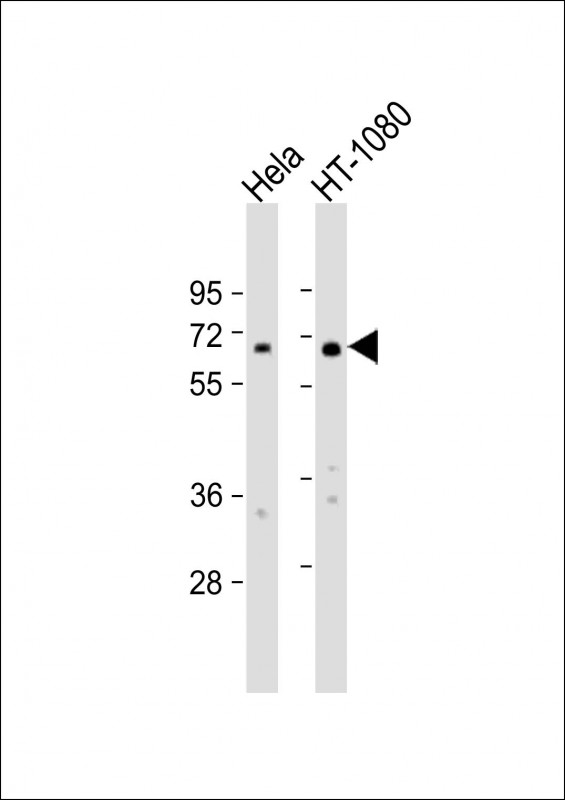IL4I1 Antibody (C-Term)
Purified Rabbit Polyclonal Antibody (Pab)
- SPECIFICATION
- CITATIONS: 1
- PROTOCOLS
- BACKGROUND

Application
| WB, E |
|---|---|
| Primary Accession | Q96RQ9 |
| Reactivity | Human |
| Host | Rabbit |
| Clonality | polyclonal |
| Isotype | Rabbit IgG |
| Calculated MW | 62881 Da |
| Gene ID | 259307 |
|---|---|
| Other Names | L-amino-acid oxidase, LAAO, LAO, 1.4.3.2, Interleukin-4-induced protein 1, IL4-induced protein 1, Protein Fig-1, hFIG1, IL4I1, FIG1 |
| Target/Specificity | This IL4I1 antibody is generated from a rabbit immunized with a KLH conjugated synthetic peptide between 391-422 amino acids from human IL4I1. |
| Dilution | WB~~1:2000 E~~Use at an assay dependent concentration. |
| Format | Purified polyclonal antibody supplied in PBS with 0.09% (W/V) sodium azide. This antibody is purified through a protein A column, followed by peptide affinity purification. |
| Storage | Maintain refrigerated at 2-8°C for up to 2 weeks. For long term storage store at -20°C in small aliquots to prevent freeze-thaw cycles. |
| Precautions | IL4I1 Antibody (C-Term) is for research use only and not for use in diagnostic or therapeutic procedures. |
| Name | IL4I1 {ECO:0000303|PubMed:16029492} |
|---|---|
| Function | Secreted L-amino-acid oxidase that acts as a key immunoregulator (PubMed:17356132, PubMed:32818467, PubMed:32866000). Has preference for L-aromatic amino acids: converts phenylalanine (Phe), tyrosine (Tyr) and tryptophan (Trp) to phenylpyruvic acid (PP), hydroxyphenylpyruvic acid (HPP), and indole-3-pyruvic acid (I3P), respectively (PubMed:17356132, PubMed:32818467, PubMed:32866000). Also has weak L-arginine oxidase activity (PubMed:26673964). Acts as a negative regulator of anti-tumor immunity by mediating Trp degradation via an indole pyruvate pathway that activates the transcription factor AHR (PubMed:32818467, PubMed:32866000). IL4I1-mediated Trp catabolism generates I3P, giving rise to indole metabolites (indole-3-acetic acid (IAA) and indole-3-aldehyde (I3A)) and kynurenic acid, which act as ligands for AHR, a ligand-activated transcription factor that plays important roles in immunity and cancer (PubMed:32818467, PubMed:32866000). AHR activation by indoles following IL4I1-mediated Trp degradation enhances tumor progression by promoting cancer cell motility and suppressing adaptive immunity (PubMed:32818467). Also has an immunoregulatory function in some immune cells, probably by mediating Trp degradation and promoting downstream AHR activation: inhibits T-cell activation and proliferation, promotes the differentiation of naive CD4(+) T-cells into FOXP3(+) regulatory T- cells (Treg) and regulates the development and function of B-cells (PubMed:17356132, PubMed:25446972, PubMed:25778793, PubMed:28891065). Also regulates M2 macrophage polarization by inhibiting T-cell activation (By similarity). Also has antibacterial properties by inhibiting growth of Gram negative and Gram positive bacteria through the production of NH4(+) and H2O2 (PubMed:23355881). |
| Cellular Location | Secreted. Lysosome {ECO:0000250|UniProtKB:O09046}. Cytoplasmic vesicle, secretory vesicle, acrosome. Note=Secreted at the immunological synapse. |
| Tissue Location | Primarily found in immune tissues, with the highest expression in lymph nodes and spleen (PubMed:12031486, PubMed:12446450). Present in germinal center macrophages and inflammatory myeloid cells and antigen-presenting cells (at protein level) (PubMed:17356132). Also present in spermatozoa (at protein level) (PubMed:25767141). Highly expressed in primary mediastinal large B-cell lymphoma, a specific subtype of diffuse large B-cell lymphoma (PubMed:12446450). Expressed by neoplastic cells of several B-cell lymphomas and by tumor-associated macrophages (PubMed:19436310) |

Provided below are standard protocols that you may find useful for product applications.
Background
Lysosomal L-amino-acid oxidase with highest specific activity with phenylalanine. May play a role in lysosomal antigen processing and presentation (By similarity).
References
Chavan S.S.,et al.Biochim. Biophys. Acta 1576:70-80(2002).
Wiemann S.,et al.BMC Biol. 3:16-16(2005).
Chu C.C.,et al.Submitted (MAY-2005) to the EMBL/GenBank/DDBJ databases.
Jikuya H.,et al.Submitted (JAN-2002) to the EMBL/GenBank/DDBJ databases.
Clark H.F.,et al.Genome Res. 13:2265-2270(2003).
If you have used an Abcepta product and would like to share how it has performed, please click on the "Submit Review" button and provide the requested information. Our staff will examine and post your review and contact you if needed.
If you have any additional inquiries please email technical services at tech@abcepta.com.














 Foundational characteristics of cancer include proliferation, angiogenesis, migration, evasion of apoptosis, and cellular immortality. Find key markers for these cellular processes and antibodies to detect them.
Foundational characteristics of cancer include proliferation, angiogenesis, migration, evasion of apoptosis, and cellular immortality. Find key markers for these cellular processes and antibodies to detect them. The SUMOplot™ Analysis Program predicts and scores sumoylation sites in your protein. SUMOylation is a post-translational modification involved in various cellular processes, such as nuclear-cytosolic transport, transcriptional regulation, apoptosis, protein stability, response to stress, and progression through the cell cycle.
The SUMOplot™ Analysis Program predicts and scores sumoylation sites in your protein. SUMOylation is a post-translational modification involved in various cellular processes, such as nuclear-cytosolic transport, transcriptional regulation, apoptosis, protein stability, response to stress, and progression through the cell cycle. The Autophagy Receptor Motif Plotter predicts and scores autophagy receptor binding sites in your protein. Identifying proteins connected to this pathway is critical to understanding the role of autophagy in physiological as well as pathological processes such as development, differentiation, neurodegenerative diseases, stress, infection, and cancer.
The Autophagy Receptor Motif Plotter predicts and scores autophagy receptor binding sites in your protein. Identifying proteins connected to this pathway is critical to understanding the role of autophagy in physiological as well as pathological processes such as development, differentiation, neurodegenerative diseases, stress, infection, and cancer.

